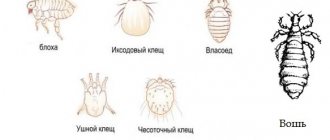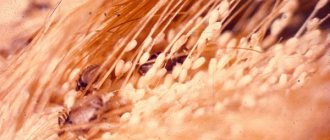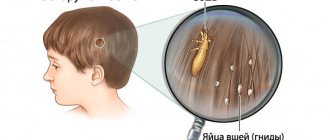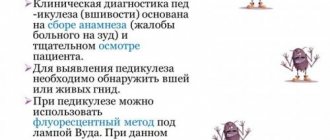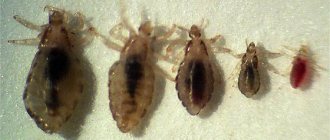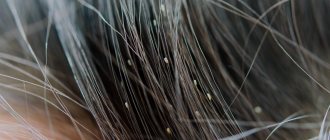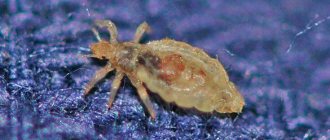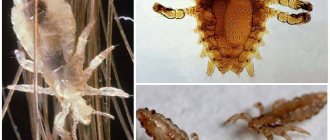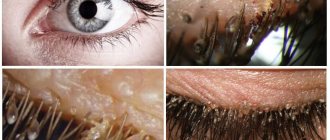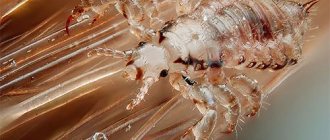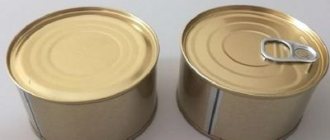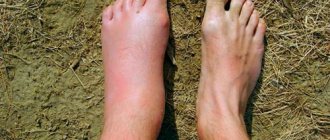- about the author
- VK profile
Svetlana Tarasova
Hairdresser-stylist with more than 8 years of experience, expert in the field of haircuts, styling, hair care, coloring.
Currently, pediculosis is a fairly common disease that affects both children and adults. In this case, the main sign indicating the presence of lice are nits on the hair, from which adult individuals subsequently grow.
Where can nits come from, symptoms
It should be noted right away that nits are the eggs of a female louse, which she begins to actively lay when she lands on a person’s head. In turn, the louse itself can appear in the hair in the following ways:
- in close contact with a person infected with lice (in public transport, places with large crowds of people, etc.),
- as a result of sharing personal hygiene items (towels, combs), hats and clothing,
- sexually (if we are talking about pubic lice).
The main symptom indicating the presence of nits is the appearance on the head of whitish capsules attached to the hair at a distance of 0.5 cm from the scalp. At the same time, immature lice do not cause any other symptoms.
REFERENCE. The most pronounced signs of pediculosis begin to appear with a significant increase in the number of adult individuals. There is almost continuous itching of the scalp, wounds form at the site of scratching, the person’s sleep is disturbed, he becomes nervous and restless. In especially advanced cases, wounds may become infected and suppurate.
Head lice
The appearance and other characteristics of head lice are as follows:
- The insect is 2-3 mm in size, has 6 legs, is gray or gray-white in color, moves very quickly, making it difficult to notice among the hair. The eyes look like 2 black dots, the front legs are equipped with claws for holding on the human body and hair, which is clearly visible in the enlarged photo. The body is almost transparent, only after being saturated with blood it changes color and becomes dark red.
- Each louse lives in the hair for up to 3 weeks, but outside it - no more than 1 day.
- The main food for the parasite is human blood, and it pierces the skin with a special proboscis with needles, using rotational movements when searching for blood vessels. Having discovered food, the insect begins to suck blood, which lasts several seconds, during which time up to 1 mg of blood is absorbed, which does not coagulate due to the production of an anticoagulant secretion secreted by the parasite.
- During lice bites, saliva is released, which after a while begins to cause skin irritation: itching appears, disturbing the patient and causing nervous discomfort. Unpleasant sensations begin to appear only 2-4 weeks after lice settle in the hair. When scratching itchy areas, wounds and ulcers form on the skin; in severely advanced cases, the hair becomes tangled and sticks together from pus after infection, which is accompanied by an unpleasant odor.
Head lice
The main signs of lice infection are itching and discomfort in the scalp, especially at the temples, behind the ears and in the back of the head. It is in these areas that lice settle on the head, where children should be examined for ectoparasites.
How do living individuals develop and what do they eat?
In its development, an adult louse goes through several stages, which in total can last for 2-4 weeks:
- Stage 1 – the female louse lays eggs (nits) approximately 1 mm in size.
- Stage 2 – the larva hatches (this occurs approximately 9 days after the egg appears). Its size is 1.5 mm. This is the first stage of the nymph.
- Stage 3 – the second stage of the nymph begins (1.75 mm).
- Stage 4 – third nymph stage (2 mm).
- Stage 5 – the appearance of an adult male (2.4-3.6 mm) or female (2.3-3 mm).
IMPORTANT. It should be kept in mind that female lice are very fertile and lay 5 eggs (nits) on their hair every day. Having noticed the first signs of the disease, it is necessary to immediately begin treatment.
Living lice lead a parasitic lifestyle and feed on human blood. In this case, the larvae begin parasitizing immediately after emerging from the egg. To grow, they need to feed every 2 hours. An adult requires a minimal amount of blood to maintain life.
Preventive measures
To avoid getting infected with lice, you need to wash your hair and body at least once a week, comb your hair daily, and change your underwear daily, not when soiled. Dirty items should be washed in warm water using detergents, use only your own bedding and hygiene items, and carry out wet cleaning regularly. It is advisable to avoid head-to-head contact with strangers and casual connections.
If one of your loved ones becomes infected, it is necessary to carry out preventive sanitary treatment of all contacts and family members. And then examine your head for 3 weeks to track the first symptoms.
Preventive measures and treatment at the first signs of pediculosis will help avoid the spread of a dangerous disease. These insects are not only a cause of anxiety and nervous disorders due to constant itching, they carry dangerous diseases - pyoderma, relapsing and typhus.
How to distinguish live nits from dead ones
Live nits can be easily distinguished from dead ones. However, the main differences primarily lie in appearance.
So, the following signs are characteristic of a living nit:
- White color,
- when illuminated, the surface of the egg shines,
- the capsule has a convex shape.
In addition, if you try to crush a live nit, it will make a characteristic click.
What do dead nits look like, why can they be dry (empty), are they transmitted?
Dead nits look like this:
- have a duller and faded appearance,
- the surface of the egg acquires a gray-yellow tint,
- capsules lose their convex shape,
- There is no click when pressed.
It should be noted that the louse egg becomes empty after the live larva emerges. At the same time, the shell itself continues to hang on the hair.
Dead nits are not transmitted in any way . However, in any case, they will have to be removed.
Medications
Since lice eggs are located near the roots, for better separation it is recommended to treat this area with acid solutions or chemical anti-pediculosis drugs. These manipulations help dissolve the adhesive substance, which helps nits stick to the hair.
Among the medications used to achieve this goal, special means are used, among which a worthy place is given to:
- aerosols Para-Plus;
- emulsions Medilis Malathion;
- Pedilin;
- Paranita;
- Sulfur ointment.
Can there be nits without lice, what to do if there are nits but no lice
Sometimes there are cases when nits are found on the head, but there are no adults. This can happen if the hair has been exposed to a chemical. For example, painting with a dye containing hydrogen peroxide can kill adult lice. However, the harmful effects of this chemical were not enough to destroy the eggs themselves.
When faced with such a situation, in any case, it is necessary to take measures to eliminate nits, since after a short time living larvae can hatch from them.
Linen lice
People need to know what linen lice look like in order to be able to distinguish them from head lice. Outwardly, they are slightly larger, settle on clothing, closer to the human body, affecting the back, sides, and limbs. Linen lice bites are always located on the body. Over their long history of existence, parasites have developed the necessary adaptations in the structure of their bodies that allow them to live on tissue, so such parasites will not be able to move to the head.
How to get rid of dry (dead) nits on hair
Unlike lice, it is quite difficult to remove nits from the head, since they are firmly attached to individual hairs. However, the most common methods of elimination are the following:
- head shaving - the most radical method that allows you to get rid of nits literally in one go. However, it should be understood that this option is not suitable for everyone, especially when it comes to the female gender.
- combing – in this case, the eggs are removed using a special fine-toothed comb.
- removing dead nits with your fingers – the hair on the head is divided into separate strands and the eggs are removed from them one by one. This method is not the most effective, since it does not allow you to get rid of dry shells 100%. In addition, such a procedure will take quite a lot of time.
How to remove dead nits from hair quickly at home
Currently, a fairly large number of methods for eliminating nits are known, ranging from mechanical action to the application of special chemical compounds to the hair.
So, the most well-known methods of influence include the following:
Combing
This method allows you to remove both living and dead nits. To do this, you must first buy a special comb at the pharmacy . Its distinctive feature is the presence of a large number of thin and frequent teeth, thanks to which the louse egg can be easily removed from the hair.
When combing, you should adhere to the following recommendations:
- the procedure should be carried out in a well-lit room,
- hair should be divided into separate strands,
- for convenience, the head can be slightly moistened or lubricated with oil,
- If your hair is very long, it is recommended to cut it a little.
You should be prepared for the fact that combing will have to be repeated more than once until the hair is completely free of nits.
Medicines
It is immediately worth noting that modern drugs against pediculosis are mainly aimed at destroying adult lice, as well as live nits. The most effective drugs include the following:
- "Nittifor" – used to combat lice, nits, ticks and fleas. Its active component is permethrin, which paralyzes the nervous system of the parasite and leads to their death. Nittifor can be purchased as a cream or lotion,
- "Foxylon" – hair lotion, the main component of which is benzyl benzoate. This substance easily penetrates the chitinous cover of parasites,
- "Pedilin" – it is based on the active substance malathion, which causes the death of lice and nits. Available in the form of shampoo or emulsion,
- other drugs against pediculosis.
REFERENCE. After using the above remedies, the remaining dead lice and nits will need to be additionally combed out using a fine-toothed comb.
Folk remedies
Many people faced with the problem of head lice often resort to various folk methods . However, you should be very careful here, since the use of this or that substance can be very dangerous.
In addition, folk remedies will also not eliminate dead nits on their own. After destruction, in any case, you will have to comb them out or remove them with your fingers.
So, the main folk remedies against nits include the following:
- treatment of the head with extracts of various plants (for example, a decoction of wormwood, beets, wild rosemary herb, etc.),
- kerosene mixed with vegetable oil - a fairly effective method of combating nits and lice. However, such a composition can cause severe poisoning of the body, as well as damage the scalp and hair. In addition, kerosene is very flammable,
- vinegar diluted with water – this product facilitates the process of combing nits out of hair. However, vinegar will not kill adult parasites. Moreover, if diluted incorrectly, you can burn your scalp.
Features of treatment in children
Treatment of head lice in children has a number of features that must be taken into account:
- Not all drugs are suitable for removing lice from a child’s head. Before use, be sure to read the instructions and ask at what age this or that product can be used,
- in the fight against lice, preference should be given to more gentle methods of action (for example, short haircuts, combing),
- Before using any drug against head lice, it is strongly recommended to consult a pediatric dermatologist or pediatrician.
ATTENTION. You need to choose folk remedies very carefully. Exposure of a child’s scalp to highly toxic substances such as kerosene, vinegar, etc. is not permissible.
Prevention of lice and nits
In order to avoid the appearance of head lice, you must adhere to the following simple tips:
- strictly observe the rules of personal hygiene,
- change bed and underwear regularly,
- periodically boil clothes during washing (if the fabric allows it),
- take good care of your hair (comb your hair regularly),
- carry out preventive examinations for the presence of nits and lice,
- under any circumstances use other people’s hats, combs, hairpins, or towels.
In addition, owners of long hair should pay attention to their hairstyle before going out into public places. It is not recommended to let your hair down, as this increases the risk of lice infection.
Children are the main risk group
Children are the main risk group for head lice infection. There are several reasons:
- failure to comply with personal hygiene rules. In a child, bloodsuckers may appear as a result of using one comb;
- close contact with each other. The child is sociable due to his age. Kids prefer group games in which contact between hairstyles is almost inevitable. And if one of them has lice, then soon the entire team becomes infected;
- increased frequency of close contacts with peers. A child has a wider social circle than an adult, and the risk of close proximity with a carrier of the disease often increases several times;
- lack of selectivity. A child will play with equal pleasure with a child both from a prosperous family and a poorly cared-for one (and even a tramp).
FAQ
Often, parents faced with the problem of childhood lice have the following questions:
Expert opinion
Eve
hair stylist
Ask a Question
The child was found to have nits, but no lice, why can this happen?
This situation is possible if the infection occurred very recently, that is, only one adult could have landed on the baby’s head, which immediately laid eggs. At the same time, the louse itself (especially if there is one or only a few of them) is quite difficult to notice. This is why it seems to parents that there are nits, but no lice.
Do dead nits click?
As noted above in the text, dead louse eggs do not produce a characteristic click when pressed on them . This is one of the distinguishing features between dead and living nits.
In conclusion, it should be noted that immediately after discovering nits on the head, it is necessary to immediately begin treatment for head lice. It doesn't matter whether they are dead or alive. In any case, lice eggs must be removed from the head.
- about the author
- VK profile
